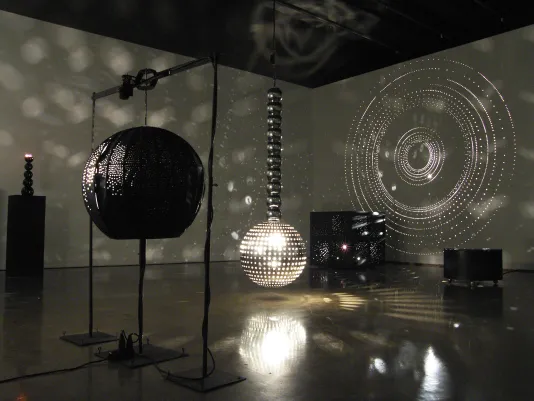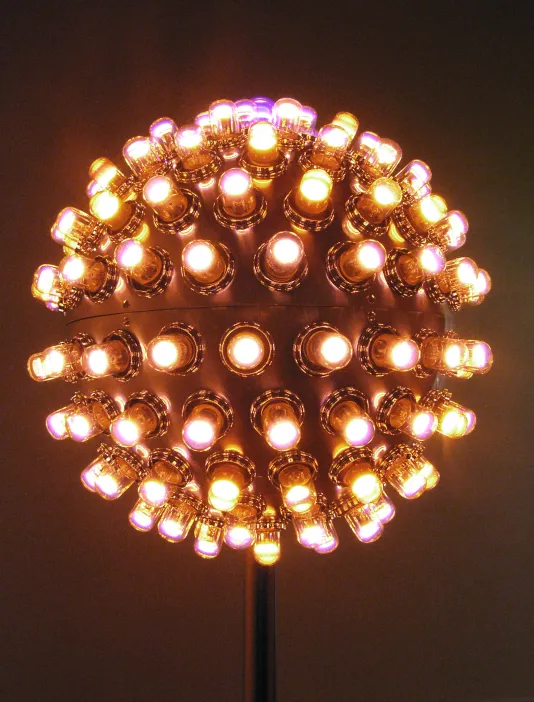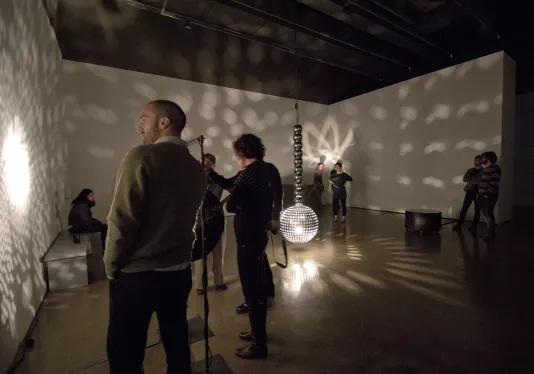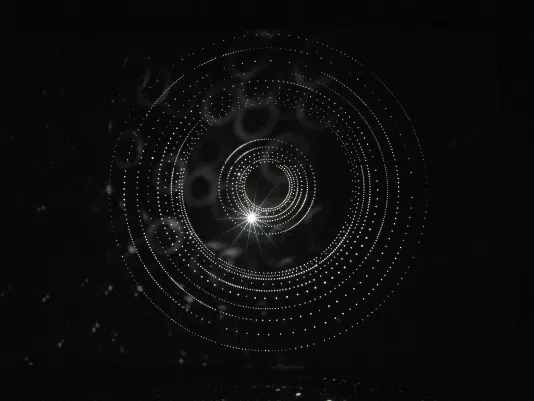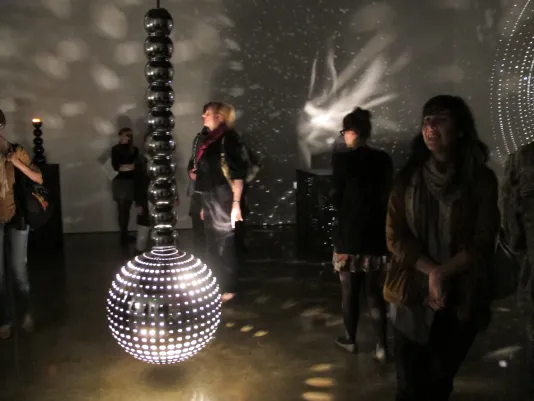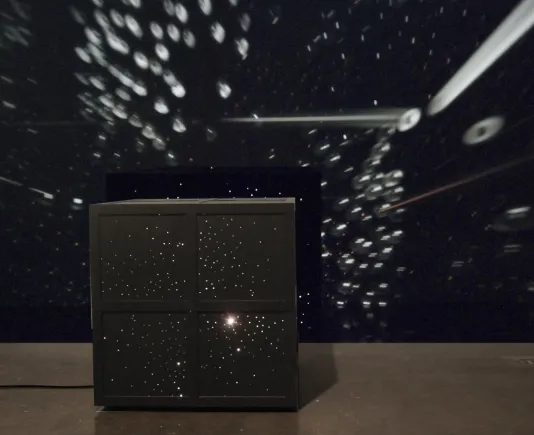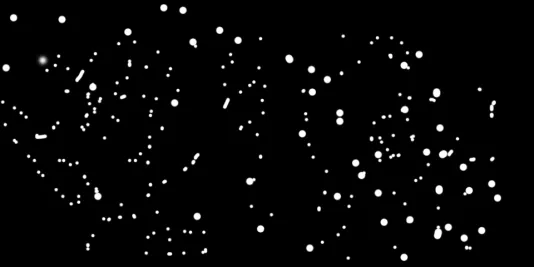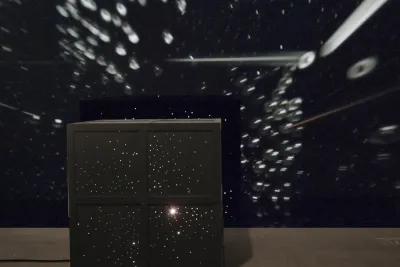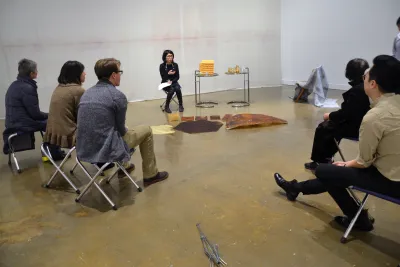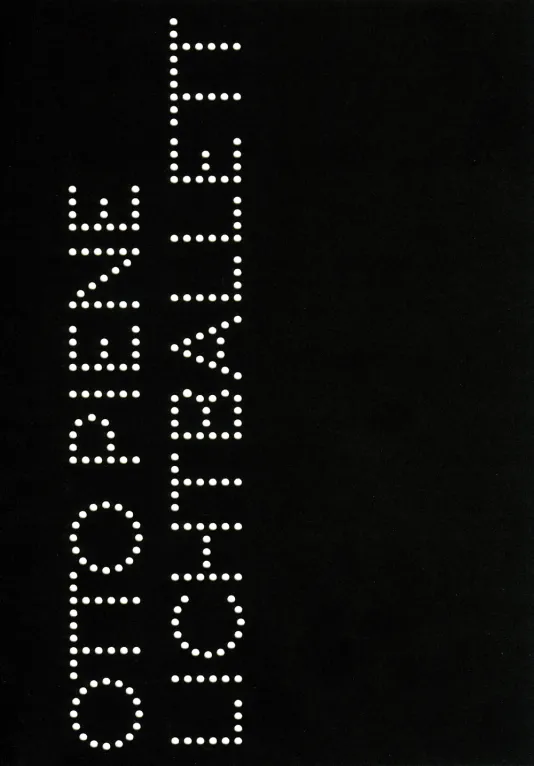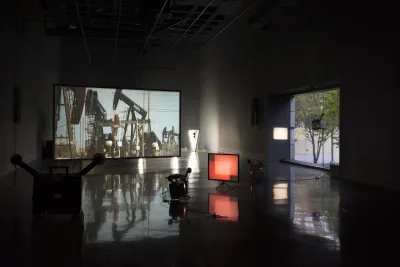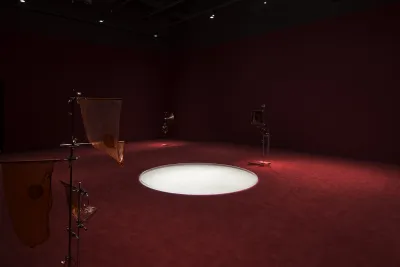Installation view, Otto Piene: Lichtballett, MIT List Visual Arts Center, 2011. Photo: Timothy Lloyd
Otto Piene: Lichtballett
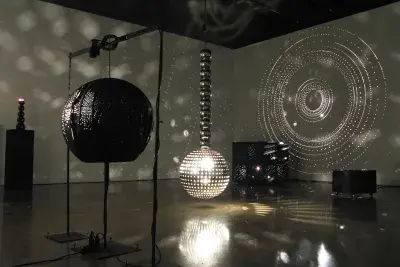
The MIT List Visual Arts Center is pleased to present an exhibition of the light-based sculptural work of Otto Piene (b. 1928, Bad Laasphe, Germany).
Piene is a pioneering figure in multimedia and technology-based art. Known for his smoke and fire paintings and environmental “sky art,” Piene formed the influential Düsseldorf-based Group Zero with Heinz Mack in the late 1950s. Zero included artists such as Piero Manzoni, Yves Klein, Jean Tinguely, and Lucio Fontana. Piene was the first fellow of the MIT Center for Advanced Visual Studies (CAVS) in 1968, succeeding its founder György Kepes as director until retiring in 1994.
Otto Piene: Lichtballett highlights the artist’s exploration of light as an artistic and communicative medium. As the artist explained in a series of texts in the 1960s, “light is the primary condition for all visibility,” leading to investigations of light movement:
When, now and today, art communicates, it is not so much a transmitter of ideas and information as it is a sender of energy. How the visually transmitted energy changes into a spectator’s emotional energy remains a secret. Certainly the dosage plays a part. The real sun burns and singes; an artistic synonym of the sun can calm and heal. Calm and quietness define the climate of the light ballet.
First produced using hand-operated lamps directed through perforated stencils, Piene’s Lichtballett (light ballet) performances of moving light became mechanized in the 1960s. The artist’s early light sculptures consisted of revolving lamps, grids, globes, and discs operated by electric switchboards, causing what he described as “the steady flow of unfurling and dimming, reappearing, and vanishing light.” These light machines evolved into kinetic sculptural environments of mechanized effects by the late 1960s.
Bringing together several of the artist’s works from the 1960s and ‘70s with two new sculptures, the exhibition is synchronized into a choreographed installation. Electric Rose (1965) consists of a polished aluminum globe covered with neon light bulbs that emit light in four sequenced phases. The piece was featured in Piene’s first solo exhibition in the United States, Light Ballet, at the Howard Wise Gallery in New York in 1965. An important work in the permanent collection of the MIT List Visual Arts Center, the piece has undergone significant restoration by Denkhaus GmbH, Düsseldorf, and is now exhibited for the first time in over two decades. The conservation process, overseen by the artist and the MIT List Visual Arts Center, included a complete rewiring of the piece, removal of surface damage and dents, and replacement of the light fixtures and bulbs to exact specifications.
The exhibition also showcases several other significant early works alongside new sculptures. The two interior lamps of Light Ballet on Wheels (1965) continuously project light through a revolving disk. The sculpture Electric Anaconda (1965) is composed of seven black globes of decreasing diameter stacked in a column, the light climbing up until completely lit. Piene’s new works produced specifically for the exhibition, Lichtballett (2011), a site-specific wall sculpture, and One Cubic Meter of Light Black (2010–11), continue his decades-long investigation of technology and light phenomena.
An original score composed by the artist for his first light performances in the 1960s will accompany several special presentations of the light ballets throughout the duration of the exhibition.
Otto Piene: Lichtballett will also be accompanied by a series of film screenings that document Piene’s work and the history and performance of the light ballets through several decades.
Otto Piene: Lichtballett is organized by João Ribas, Curator, MIT List Visual Arts Center.
About the Artist
A leading figure in kinetic and technology-based art, Otto Piene (1928-2014) was born in Bad Laasphe, Germany. After studying painting and art education at the Academy of Art in Munich and the Kunstakademie Düsseldorf, and philosophy at the University of Cologne, Piene founded the influential Group Zero in Düsseldorf with Heinz Mack and Günther Uecker in 1957. Piene was the first fellow of the MIT Center for Advanced Visual Studies (CAVS) in 1968, succeeding founder György Kepes in 1974 as its director until retiring in 1994. Piene had his first solo exhibition in 1959 at Galerie Schmela in Düsseldorf and has had numerous exhibitions and retrospectives, including at the Kunstmuseum im Ehrenhof, Düsseldorf, in 1996, and at the Prague City Gallery, Prague, in 2002. His works are included in nearly two hundred museums and public collections around the world including the Museum of Modern Art, New York; the Nationalgalerie Berlin; the Walker Art Center, Minneapolis; the National Museum of Modern Art, Tokyo; the Stedelijk Museum, Amsterdam; the Centre Georges Pompidou, Paris; and the MIT List Visual Arts Center. Piene represented Germany at the Venice Biennale in 1967 and 1971, and exhibited at documenta in Kassel, Germany, in 1959, 1964, and 1977. Piene’s Centerbeam (1977), a pioneering multimedia work created with a team of artists for documenta 6, was later exhibited on the National Mall in Washington, DC. For the closing ceremony of the 1972 Munich Olympics, Piene created Olympic Rainbow, a “sky art” piece comprised of five helium-filled tubes that flew over the stadium. Piene received the Sculpture Prize of the American Academy of Arts and Letters in 1996. He lives and works in Groton, Massachusetts, and Düsseldorf, Germany.
Sponsors
Funding for Otto Piene: Lichtballett has been generously provided by the David Bermant Foundation, the Barbara and Howard Wise Endowment for the Arts, the Goethe-Institut Boston, the Council for the Arts at MIT, and the Massachusetts Cultural Council.
